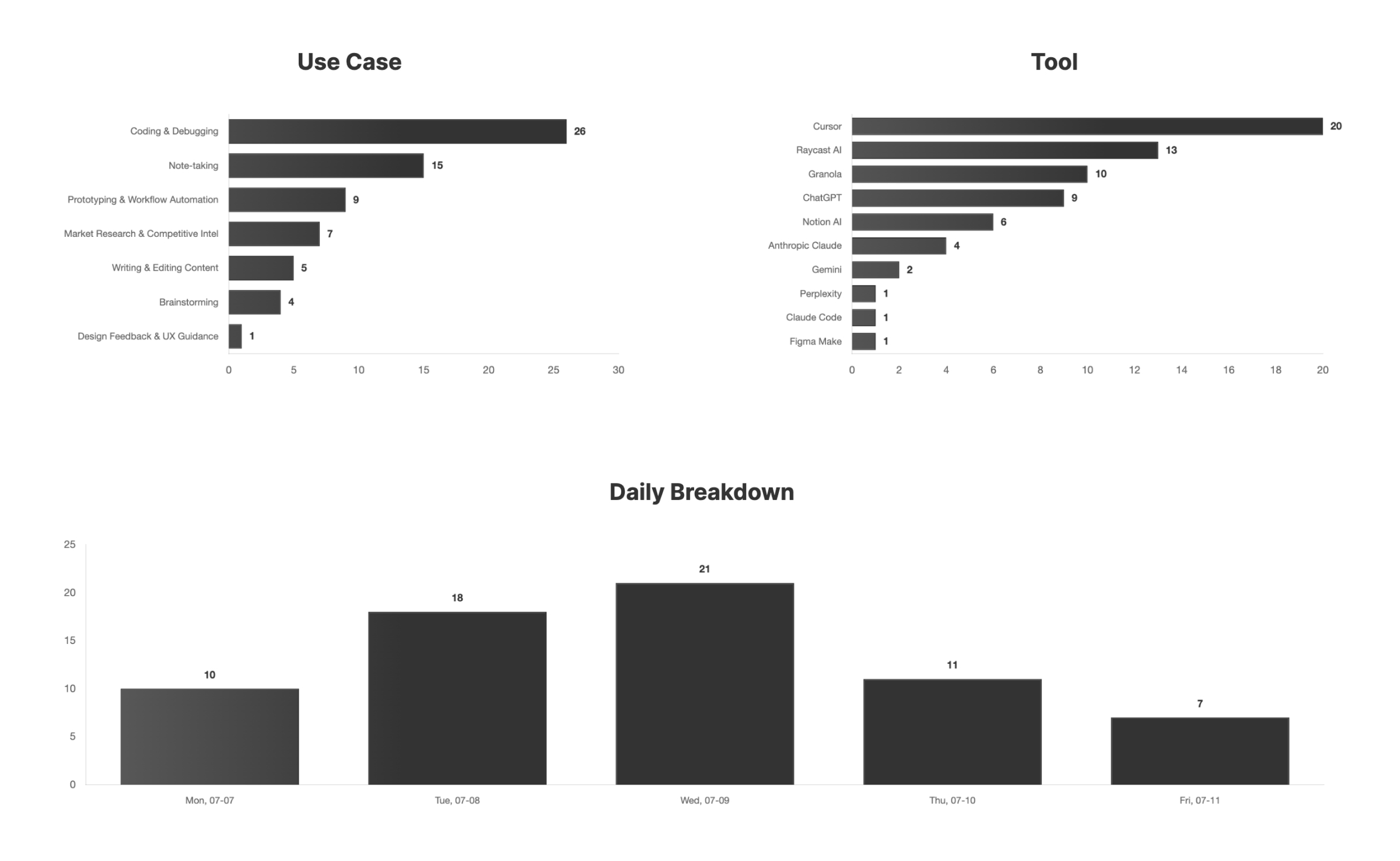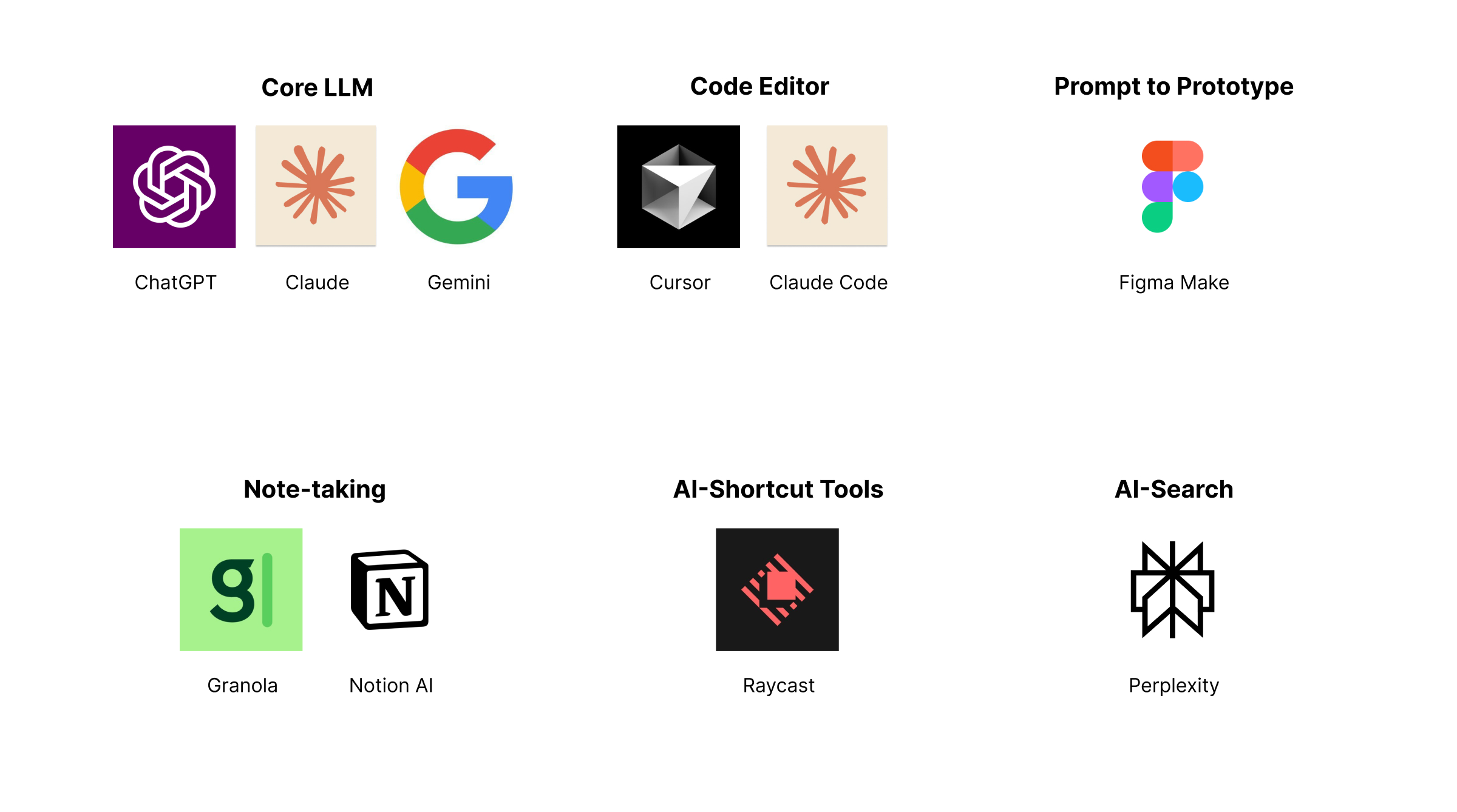Product Designer AI Audit: Tracking AI interactions for a week

For me this entire year has been spent exploring "AI-First", and "AI-powered design". As an experiment I wanted to get a clear picture of what that actually looks like in my day-to-day (July 2025). So, I ran a simple experiment:
For one week, I kept a log of every time I used a different AI tool. I built a custom Raycast extension that prompted me with a two-step questionnaire where I filled out the use case and the specific application. This approach helped me gather raw data and usage patterns.
As a design leader at AlphaSense, a big part of my role is staying on top of the latest tools and trying to help us figure out what it means to be an "AI-First" design team. Here is what I learned:
Key Takeaways, from the experiment
I used AI 67 times in a week—around 9x/day.
As someone who considers themselves an early adopter, that number felt much lower than I imagined. It's possible I missed some interactions, but it seems like a good starting point.
37% of my usage was for coding & prototyping.
This was the biggest category by far. I use Cursor and Claude Code to help me write code, fix bugs, and prototype my designs, which often helps speed up the design process by allowing me to try out my work in the final medium. I find that prototyping often feels more flexible and fluid than working in Figma and the quality is much higher and closer to the final product. This is a great outcome of AI-powered design.
20% of usage was for passive note-taking.
I used tools like Notion AI and Granola to record meetings, but I rarely returned to the notes. Turning on AI Notetaking has become so seamless and easy that it's something I frequently reach for.
More details
Use cases and categories
I bucketed my AI interactions into 7 categories to make the data actionable:
| Category | Usage | Description |
|---|---|---|
| Coding & Debugging | 26 | Code writing, fixing errors, engineering workflows, and using libraries/tools |
| Note-taking | 15 | Taking notes, summarizing, and organizing information |
| Prototyping & Workflow Automation | 9 | Rapid prototyping, scripting tools, and AI-in-the-loop design or research tools |
| Competitive Intel & Research | 7 | Summarizing news, tracking industry trends, analyzing competitors, using LLM as Search Engine |
| Writing & Editing Content | 5 | Content creation, rewriting for clarity or tone, executive updates, slide copy, and Slack message refinement |
| Brainstorming | 5 | Idea generation, design exploration, product thinking, and self-assessment |
| Design Feedback & UX Guidance | 1 | Design systems, layouts, user flows, and product cohesion |
Current AI Tools

| Category | Tools |
|---|---|
| Core LLMs | ChatGPT, Gemini, Claude |
| Code editors | Cursor, Claude Code |
| Prompt to prototype | Figma Make |
| Note-taking | Granola, Notion AI |
| Spotlight style AI tool | Raycast AI |
| Search engine | Perplexity |
How I captured the data
To keep things lightweight, I used a custom Raycast shortcut (CMD + CTRL + T) that triggered a two-step form asking:
- What was the use case?
- Which tool did I use?
It was quick enough to stay consistent—and I’m exploring how to automate this next with screen time or a native tracker. View the code for my Raycast extension here.
Final Thoughts
AI is clearly becoming a key part of my daily workflow, but often I feel like I'm only scratching the surface of what's truly possible. For me, currently the biggest ROI has been prototyping, coding, and having a fast feedback loop to help iterate and drive for great outcomes.
I'd love to hear your thoughts on this experiment and learn how others are using AI in their day-to-day. I believe our design workflows will look very different in the next 5 years. I'm hoping to build even better tooling to capture usage in the future.